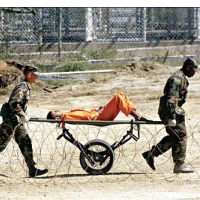Why are More Than Half of Guantánamo Prisoners now on Hunger Strike?

Like previous “national security” prisoners from Mahatma Gandhi to Bobby Sands, nearly 2 of 3 Guantánamo prisoners are on hunger strike because they have concluded that this extreme form of self-abuse is the only way to make their voices heard. Isolated at the heavily guarded military base in Cuba, the 166 prisoners—86 of whom have been cleared of all charges but not released—have little ability to communicate their plight to the outside world. However, media coverage of their hunger strike may have given them the megaphone they needed.
As an unnamed source at the International Red Cross, which has protested the detainee’s treatment and conditions, told The Guardian newspaper, “The hunger strikes are a reflection of the desperation of individuals who have no clear perspective on their future.”
The strike was initially provoked by what one prisoner called a “shakedown” on February 6, when guards confiscated personal items and were “rifling through the pages of many Korans and handling them roughly.” By March 5 or earlier, six prisoners had commenced a hunger strike to protest their continued indefinite detention without charges or trial. Their numbers doubled to at least 14 by March 15, 37 by March 29, 84 by April 21, and has stood at 100 since April 27. According to attorneys for the prisoners, however, the strike started earlier than March 5 and is larger than the government admits.
The strikers have not died because the federal government refuses to let them, force-feeding them via tubes pushed through their nostrils, down their throats and into their stomachs. At present, 23 of the 100 strikers are being force-fed, and five are hospitalized. Although the military claims it performs the feedings “gently,” attorney David Remes, who represents several Guantánamo detainees, rebutted that with the words of one of his clients: “It can be extremely painful. One of my clients said that it's like having a razor blade go down through your nose and into your throat.”
Echoing that view, several United Nations human rights officials last week demanded an end to the force-feeding, calling it a form of torture. “Hunger strikers should be protected from all forms of coercion, even more so when this is done through force and in some cases through physical violence,” they wrote in a statement.
Further complicating matters, especially for military doctors and nurses, Dr. Jeremy Lazarus, president of the American Medical Association (AMA), last week sent a letter to Defense Secretary Chuck Hagel restating the AMA’s long-standing view that force-feeding mentally competent but unwilling adults is a violation of medical ethics and urging Hagel “to address any situation in which a physician may be asked to violate the ethical standards of his or her profession.”
Although President Barack Obama has repeatedly stated his desire to close the prison at Guantánamo because it harms U.S. interests more than it serves them, he has been prevented from doing so by Congress, which passed legislation in 2009 barring federal spending on transferring the prisoners to U.S. prisons.
There are several theories as to why the 86 cleared prisoners have not been released. For some, returning to their native countries would expose them to retaliation by their governments. For others, such as those from Yemen, the Obama administration may feel that the political situation there is too volatile, and the released prisoners might join terrorist groups, either voluntarily or involuntarily.
-Matt Bewig
To Learn More:
What Happens when a Guantánamo Detainee Gets Force-Fed (by Max Fisher, Washington Post)
American Medical Association Questions Guantánamo Force-Feedings (by Jane Sutton, Reuters)
Kafka at Gitmo: Why 86 Prisoners are Cleared for Release but Might Never Get It (by Max Fisher, Washington Post)
Despair Drives Guantánamo Detainees to Revolt (by Charlie Savage, New York Times)
Tracking the Hunger Strike (Miami Herald)
Hunger Strike and Violence at Guantánamo after 10 Years without Trial (by Noel Brinkerhoff, AllGov)
- Top Stories
- Unusual News
- Where is the Money Going?
- Controversies
- U.S. and the World
- Appointments and Resignations
- Latest News
- Trump to Stop Deportations If…
- Trump Denounces World Series
- What If China Invaded the United States?
- Donald Trump Has a Mental Health Problem and It Has a Name
- Trump Goes on Renaming Frenzy






Comments